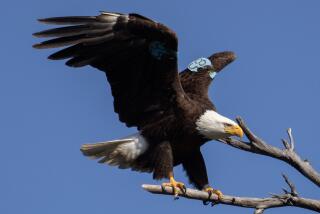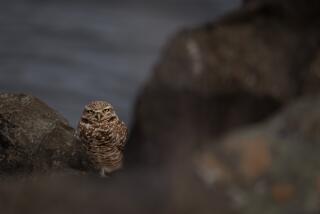These condor chicks have a better chance in the wild, thanks to the L.A. Zoo
Six condor chicks were recently born at the Los Angeles Zoo, thanks to a new breeding technique that officials hope will strengthen the endangered bird’s population.
Only about 500 California condors exist in the world, and zoo staff have spent decades breeding the birds in hopes that they would be strong and stable enough to be released into the wild.
Now, the L.A. Zoo says it has found a better way to make that happen.
Typically, when there are more chicks at the zoo than adult condors to care for them, some of the babies are hand-raised by staff members, officials say. But with its new technique, the zoo will allow adult condors to take care of more than one chick, which increases their chances of survival in the wild.
The breeding process begins when a condor lays an egg. The egg is examined, and, if fertilized, it is placed in an incubator with regular monitoring for about 57 days, zoo officials say. When the egg is close to hatching, it is put with an experienced condor capable of raising the baby bird.
The zoo’s new breeding method was first tested in 2017 with an adult bird named Anyapa, who was allowed to care for two chicks instead of one. The two babies she raised have since been released into the wild and have adapted well, according to zoo records.
With Anyapa’s success, the zoo continued to test the technique over the past two years with additional birds. It’s the first time any zoo has tried this method, the institution announced.
“Allowing our condor parents to raise two chicks at the same time is a breakthrough that our talented staff has developed to help the U.S. Fish and Wildlife Service’s efforts to reestablish a sustainable population of California condors in the wild,” said Mike Maxcy, curator of birds at the L.A. Zoo. “The six chicks born this year will now have a better chance at adapting to the wild when they are older.”
The zoo will work with the wildlife service to return the six newest chicks to the wild — either in Big Sur, Bitter Creek National Wildlife Refuge or Pinnacles National Park.
There were only 27 California condors left in the world in 1987, but a breeding program created by federal and state agencies has increased the number to about 500, according to zoo officials. About half of those birds live in the wild.
The giant raptors still face dangers, such as habitat loss, pesticide contamination and lead bullet fragments used to kill wild animals, which the condors sometimes find and eat, making the breeding program all the more important, the zoo says.
alejandra.reyesvelarde@latimes.com
Twitter: @r_valejandra
More to Read
Start your day right
Sign up for Essential California for news, features and recommendations from the L.A. Times and beyond in your inbox six days a week.
You may occasionally receive promotional content from the Los Angeles Times.







